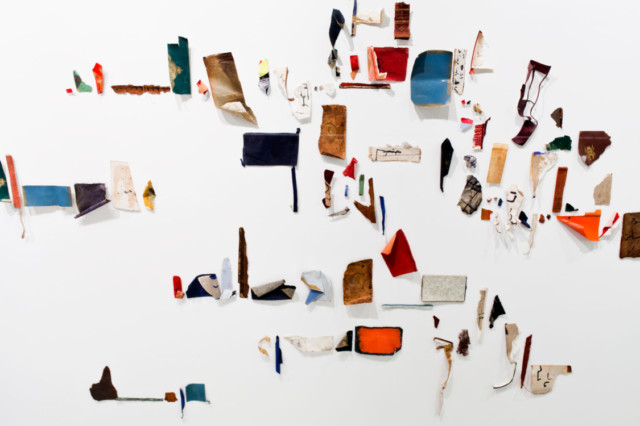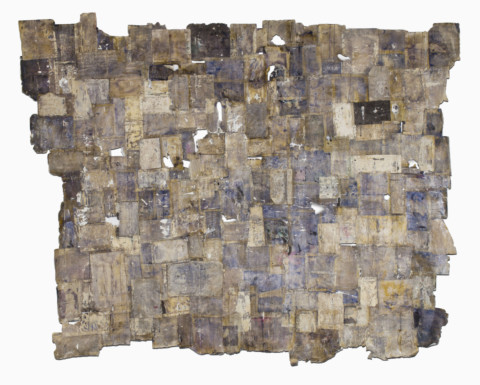
If Syrian artist Issam Kourbaj is angry he doesn’t show it. If he is fearful or sad it is not immediately obvious in his work. Not for him the savagery of his fellow Syrian artists such as Khalil Younes and Sulafa Hijazi, both contributors to the anthology of works, “Syria Speaks”, recently reported in the Gulf News.
No, the work is understated and subtle — it reaches the head before it touches the heart — the viewer has to excavate the truth as one might expect in an exhibition entitled “Unearthed”.
Kourbaj who uses old book covers, sheets of paper, bits and pieces says: “I pick up other people’s rubbish and make them into a work of art. I like the sound of words such as palimpsest, excavation and unearthed because they reflect what I am trying to do. I like the smell of paper. I like getting to know things by looking and touching, there are so many questions in the ceremony of knowing. There are ghosts inside these beautiful objects and I am interested in excavating them.”
Issam Kourbaj, as thoughtful as his art, was born in Syria and studied in Damascus and St Petersburg, before settling in the United Kingdom, where he teaches at the University of Cambridge as artist-in-residence at Christ’s College.
Inevitably the exhibition at the P21 Gallery in London is inspired by the three years of the Syrian Revolution and proceeds from the exhibition will be donated to the charity Médecins sans Frontières.
“I shudder to think of what the children of Syria are going through,” Kourbaj says. “How all the beautiful and fragile things that make up a child’s life have been torn to pieces and buried in shattered fragments under the ground. I have tried to capture their suffering with subtlety but to do that without anger is a struggle for me.”
A crushed tricycle, which he first created at the time of the first Iraq war in 2003 is an obvious symbol. The three wheeler was first displayed on the floor but now he has fixed it to wall.
“Nothing has been solved, the conflicts go on,” he says. “Other children are born, other children are still dying so I put it up on the wall because the children who survived have grown up.”
Typical of his work is “Border”, the other side of the sky. It is a large billboard he found in Yorkshire a few years ago and brought back to Cambridge, folded in the back of his car. It had been used for hundreds of adverts which had been stuck one on top of another.
“I didn’t know what I was going to do with it but I liked the rustiness of it. It is like a war machine, like the wing of an aircraft falling down, but it is also like a border wall.
“There were also tiny pieces of adverts — for supermarkets, coffee, iPhones, everything — which were stuck on the wall with pins, like Darwin did with his beetles. I wanted to put the wings of the aeroplane on the wall so I found a massive rusty nail to be a ‘pin’. I wanted something underneath to show what has fallen off the side of the poster that we don’t see, the one facing the wall, so I scattered scraps from the posters on the floor. They represent the hopelessness of my fellow Syrians who are trying to emigrate to Lebanon, Turkey or Jordan but are faced with this rusty border and left dreaming of another life.”
“Unearthed” illustrates his fondness for using book covers. Stretching across the width of the gallery scores of decorated covers are crossed by black lines like the ribbons of mourning traditionally placed on photographs of the dead. But here there are no faces just blank images of forgotten souls who have perished in the conflict.
He took the first pages of books to create “Damascus I” and “Damascus II” and inked, waxed or sanded, them before sticking them together in many layers to create an aerial representation of the city as well as a wall — a recurring theme.
“I am trying to show the streets and alleyways,” he says. “Damascus II has more cut out blank spaces and with its buckled shapes and black markings is a reference to the conflict. I like the idea of pages, they carry their own history, their own signature. It’s the way I work. I have something in my head and I will try this way or that and use what I find. Here I have added the colours of skin, metal and rust to capture the historical old buildings of Damascus.”
Many of his pieces reflect Syria as the “navel” of civilisation with its history stretching from pre-historic times, to the Romans, the Crusaders to today’s “political situation” as he wryly describes it.
He says: “Many ancient civilisations left great landmarks but over the last three years, I have witnessed the war machines of the 21st century destroy my country and my work has become a reflection of this conflict.”
It is also, inevitably, a reaction to the plight of the people. Kourbaj, who was born in the southern town of Swadia, — called the “black town” after the volcanic basalt that is used to build the walls of the houses — has many relatives still there, though, fortunately it is not an area heavily involved in the violence.
“I worry about them,” he says. “Every news bulletin from Syria reminds me of the inhuman conditions and atrocities that courageous women, children and men face there.
“This is the typical story. Because we are a Druze minority in Swadia we are out of way — we don’t have too many guns and people killing each other as they do in other places.
And he adds with a philosophical shrug as if it was only to be expected: “But I know I am on a blacklist — of that there is no doubt. The minute the authorities know what I am doing here they will punish my relatives. Of course they will.”
His most personal work, “Counting, Alphabetising”, is dedicated to his mother. It compromises apparently random scraps of paper pinned to the wall which stretches along one wall of the gallery and is inspired by his mother who wrote out Arabic letters and numbers for Kourbaj’s two sons, Mourad and Sami, who she represented, rather endearingly, as two small birds.
“My mother, who died in 2007, had little learning but she taught me what she could and then I helped her re-learn the Arabic alphabet. She in turn passed this on to my children. The shapes made by the scraps of paper and cardboard are reflections of the lines and clusters of her drawing.
“As this conflict continues, we search for evidence. People disappear so any small piece like these becomes precious as if they are evidence of their existence. I am not trying to be literal, I am not in your face, that is not the language I use. If you don’t know what it’s all about, it’s fine because it is very complex and it cannot be seen in one go because it takes up so much space — but then you can’t perceive the whole conflict in one go.”
Surprisingly one way to understand this array of bits and pieces is to listen to the music which is played throughout by Syrian composer Malek Jandali entitled “Echoes for Ugarit”, an ancient city in the north of the country.
“Think about the work musically,” says Kourbaj. “The pieces of paper are like musical notes. It’s a time piece.”
As an artist with a background in fine art, architecture and theatre design, it is no surprise that the exhibition stages some of his installations.
The most striking is “Excavations” — a small blacked-out room alongside the street. A camera obscura lets in shafts of light and allows the viewer to peer through lenses to the outside world. They are like bullet holes, a powerful representation of the Syrians who are trapped inside their houses while the conflict rages outside.
The artist’s words are played over, comparing his work with an artist friend who is still working in the country
“So many art works are coming out of the conflict and from the ground. Being there gives a different perspective — the smell of the guns is very different from a distance. We are both looking at the same conflict but through a completely different window. I am trying to show the people trapped inside, seeing the outside world being ruined, the landscape being fragmented. The lenses show the world upside down, confused and chaotic.”
His “Diary”, a selection of book covers ranged on narrow shelves entitled 174 weeks and ongoing, represents each week of the conflict but not in any chronology or in a way that reflects a specific event.
“I do not have anything particular in mind when I do them,” he says. “Because I watch the news every day I think maybe I will do something of a particular nature but I am not illustrating what I have seen or heard. I’m reacting, not recreating. My function is not to blame. I am not a politician, I am an artist and I translate what I hear into an artistic form and this is much too precious for me than to say which side I am on.”
You might need another shelf for his diary, I suggest.
“Many,” he agrees resignedly. “Yes, we will need many shelves. I am not optimistic; this conflict will go on for a long time.”
Richard Holledge is a writer a writer based in London
Unearthed by Issam Kourbaj will run at P21 gallery in London through August 16.













